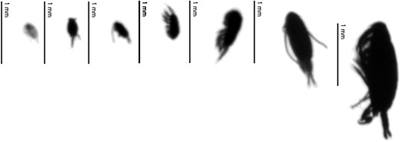Zooplankton play a key role in pelagic food webs, and due to their high abundances, relatively short life cycles, and narrow thermal tolerances, their populations are greatly and rapidly influenced by changes in the environment. These characteristics, along with the low amount of direct human exploitation, make them excellent candidates to study the effects of climate change on marine, pelagic ecosystems.
Changes in sizes of zooplankton can have large impacts on the survival of organisms in higher trophic levels. Micro- and mesozooplankton are common food items for larval fishes, and variations in zooplankton populations can have large impacts on larval fish survival. Copepods in particular are key components of larval fish diets and sometimes are the only prey items for many resident and migratory larval fishes of both commercial and ecological importance. Due to their short life cycles (usually weeks to months) and their high abundance, key position in pelagic food webs, and high sensitivity to environmental change, investigating the impact temperature has on copepod community body size will provide critical information on how climate change could affect pelagic ecosystems.

In their new study titled "Long-term increase in copepod community body size in a temperate estuary over a 40-year times series", graduate student Nayan Mallick, his mentor Dr. Josh Stone, and their collaborator Dr. Dennis M. Allen (Baruch Marine Field Laboratory, USC) investigated long-term changes in copepod community body size in a temperate estuary in the Southeastern United States. Mesozooplankton samples were collected twice each lunar cycle from 1981 to 2020 during the months of March to July. They found strong evidence for a long-term increase in body size, likely driven by shifts in species composition, with the most rapid increase occurring during the most recent decade (2011–2020). Temperature was inversely related with monthly mean body size, potentially driving the seasonal shifts in size, but was not correlated with the observed long-term trend. Overall, results from this study showed a long-term increase in copepod community body size that was not directly linked to changes in temperature but instead to changes in species composition.